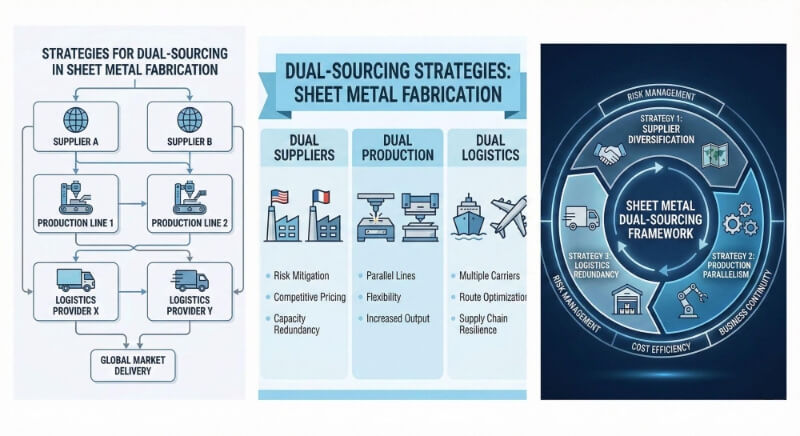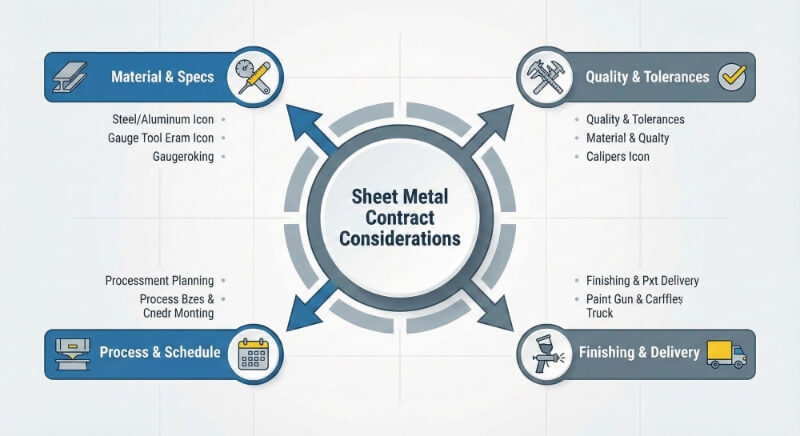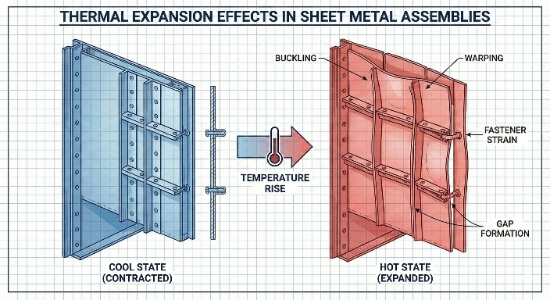Copper has long been a crucial material in manufacturing due to its excellent electrical and thermal conductivity. With the rise of 3D printing technologies, manufacturers now leverage copper’s properties to create complex, high-performance parts. This guide explores the fundamentals, benefits, and applications of copper 3D printing.
What is Copper 3D Printing?
Copper 3D printing is additive manufacturing in which copper powder or wire is layered and fused to build a part. Traditional methods like casting and machining have trouble with copper, as its high reflectivity and heat conductivity make it challenging to work with.
Recent advances in laser and extrusion-based 3D printing have changed this. Manufacturers can now create detailed copper parts with high accuracy and efficiency.
How Does Copper 3D Printing Work?
Copper 3D printing transforms digital designs into physical parts using additive manufacturing. Here’s a step-by-step breakdown of how it works.
Design the 3D Model
Start with a digital 3D model created using CAD software. This model defines the shape, size, and features of the part.
Prepare the File
The 3D model is sliced into thin layers using specialized software. This creates a file that the 3D printer can read and execute.
Set Up the Printer
Load the copper powder or wire into the 3D printer. Ensure the build platform is clean and properly calibrated for accurate printing.
Print the Part
The printer deposits or melts the copper material layer by layer. Techniques like Selective Laser Melting (SLM) use a laser to fuse the powder, while Direct Energy Deposition (DED) melts wire or powder as it’s deposited.
Post-Processing
After printing, the part may need additional steps like heat treatment, polishing, or machining to achieve the desired finish and properties.
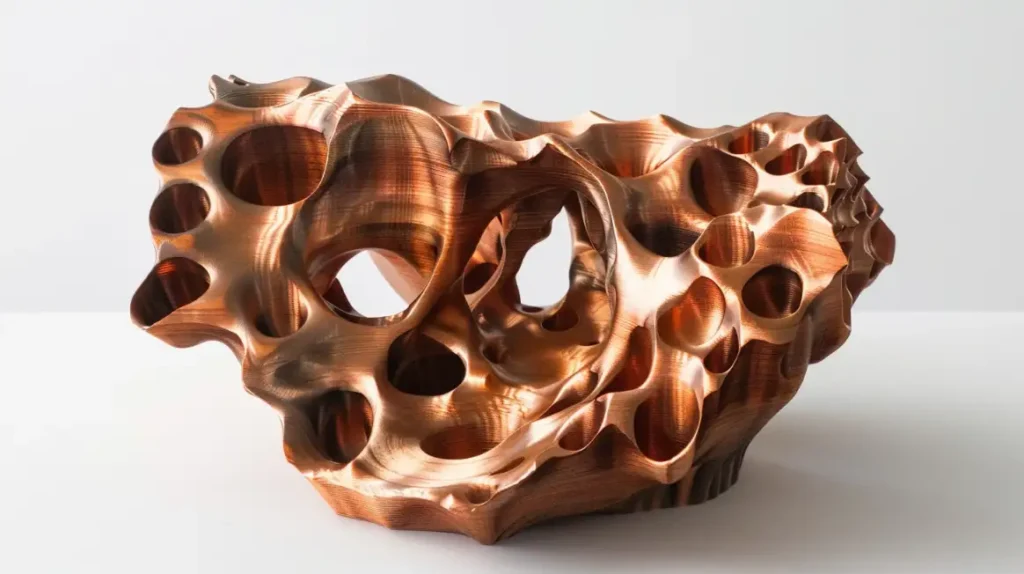
Properties of 3D Printed Copper
3D printed copper components demonstrate distinct properties compared to traditionally manufactured copper:
Thermal Conductivity
Copper’s excellent thermal conductivity makes it valuable for heat management applications. 3D printed copper typically achieves 85-95% of the thermal conductivity of wrought copper, depending on printing technology and parameters.
Electrical Conductivity
Electrical conductivity is a key property for many copper applications. Current 3D printing technologies can achieve:
- DMLS: 80-90% IACS (International Annealed Copper Standard)
- EBM: 85-95% IACS
- BMD: 75-85% IACS
Mechanical Properties
3D printed copper’s mechanical properties depend heavily on porosity, build orientation, and post-processing:
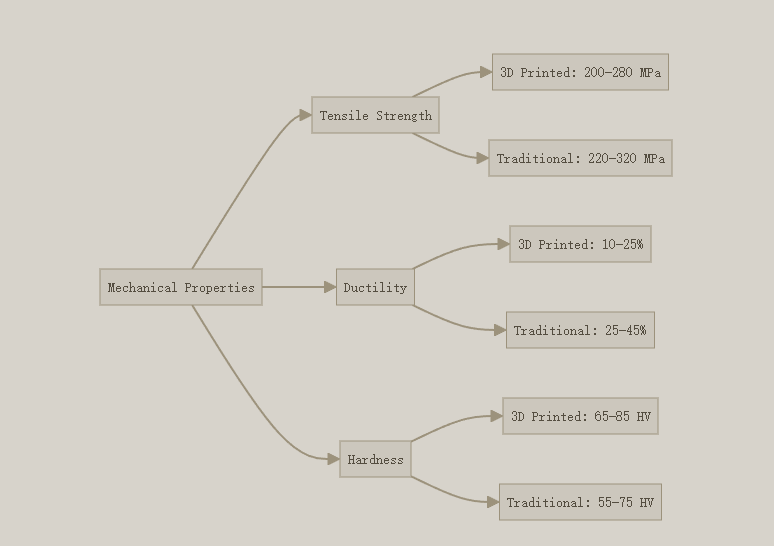
Current Copper 3D Printing Technologies
Several 3D printing technologies are compatible with copper. Each method has unique advantages and is suited for specific applications.
Direct Metal Laser Sintering (DMLS)
DMLS uses a high-powered laser to melt copper powder. The laser follows the shape of each layer based on a 3D model. After each layer, the build platform lowers, and a new layer of powder spreads across the surface.
DMLS provides high accuracy (±0.1mm) and can produce parts up to 99.5% density. The process creates substantial parts, but copper’s high reflectivity makes it harder to absorb laser energy. New green and blue lasers have helped solve this problem.
Electron Beam Melting (EBM)
EBM uses an electron beam instead of a laser to melt copper powder. The process happens in a vacuum, which prevents copper from oxidizing.
The electron beam is more energy-efficient than lasers and reduces stress in the printed parts. This lowers the chances of warping and distortion, which are common when printing copper.
Bound Metal Deposition (BMD)
BMD uses copper particles mixed with a polymer binder. The material is pushed through a nozzle, like in FDM printing. After printing, the part goes through a debinding step to remove the polymer, then sintering to fuse the copper particles.
BMD has some advantages. The equipment is cheaper, easier to use, and safer because it doesn’t involve loose metal powder. However, parts shrink by 15-20% during sintering, which must be considered in the design process.
Binder Jetting
Binder jetting works by spraying a liquid binder onto a bed of copper powder. A print head moves across the surface, adding the binder where needed. After each layer, the platform lowers, and a new layer of powder spreads.
The printed part called a “green” part, must undergo sintering to fuse the copper. This method is faster than laser or electron beam printing and can produce multiple parts simultaneously.
| Technology | Resolution | Material Density | Surface Finish | Cost | Speed | Complexity Capability |
|---|---|---|---|---|---|---|
| DMLS | High (±0.05mm) | 97–99% | Good | High | Moderate | Excellent |
| EBM | Medium (±0.1mm) | >99.5% | Fair | Very High | Fast | Very Good |
| BMD | Medium (±0.1mm) | 95–98% | Fair | Moderate | Slow | Good |
| Binder Jetting | Medium (±0.1mm) | 92–97% | Fair | Moderate | Very Fast | Good |
Applications of Copper 3D Printing
Copper 3D printing is transforming industries by enabling the production of previously difficult or impossible parts to manufacture. Below are some key applications:
| Industry | Application | Benefits |
|---|---|---|
| Electronics | Circuit boards, connectors, and antennas | High electrical conductivity and design flexibility. |
| Aerospace | Heat exchangers and cooling systems | Lightweight, complex geometries, and efficient thermal management. |
| Medical | Antimicrobial implants and instruments | Corrosion resistance and biocompatibility. |
| Automotive | Electric vehicle components | Improved thermal management and reduced weight. |
| Energy | Heat sinks and solar panel components | Enhanced thermal conductivity and durability. |
Benefits of Copper 3D Printing
Copper 3D printing offers several advantages, making it a valuable tool for engineers, designers, and manufacturers. Here’s a closer look at its key benefits.
Design Freedom
3D printing allows for complex geometries that traditional methods can’t achieve. You can create intricate internal structures, lightweight designs, and custom shapes tailored to specific needs. This flexibility opens up new possibilities for innovation.
Material Efficiency
Additive manufacturing uses only the material needed to build the part, reducing waste. Unlike subtractive methods, which cut away excess material, 3D printing adds material layer by layer, making it a more sustainable option.
Cost Savings
While the initial setup can be expensive, 3D printing often reduces costs in the long run. It eliminates the need for costly tooling and molds, especially for prototypes and low-volume production. It also speeds up the design-to-production cycle.
Performance
Copper’s excellent thermal and electrical conductivity enhances the performance of 3D-printed parts. Whether it’s a heat exchanger, electrical component, or custom tool, copper 3D printing delivers durable, high-performance results.
Challenges and Considerations
While copper 3D printing offers many benefits, it also has unique challenges. Understanding these can help you plan and optimize your projects.
High Reflectivity
Copper’s reflective nature makes it difficult for lasers to melt the powder consistently. This can lead to uneven melting and affect the quality of the final part. Specialized equipment and precise laser settings are often needed to overcome this issue.
Thermal Conductivity
Copper’s high thermal conductivity can be both a benefit and a challenge. While it’s great for heat management, it also means heat dissipates quickly during printing, making it harder to maintain the right temperature for proper layer fusion.
Oxidation
Copper oxidizes quickly when exposed to air, weakening the part and affecting its surface quality. Printing in an inert gas environment, like argon or nitrogen, helps prevent oxidation and ensures better results.
Post-Processing Requirements
After printing, copper parts often need additional steps like heat treatment, polishing, or machining. These processes improve the part’s strength, surface finish, and overall quality but add time and cost to the production cycle.
Conclusion
Copper 3D printing has changed manufacturing by allowing more design freedom and better performance. While there are still challenges, new technology is making the process more practical for more applications.
At Shengen, we are dedicated to offering complete manufacturing solutions. We combine advanced technologies like copper 3D printing with our expertise in sheet metal fabrication to meet our customers’ needs.
If you want to leverage the benefits of copper 3D printing, we’re here to help. Contact us today to discuss your needs and discover how we can bring your designs to life with precision and efficiency.
FAQ: Copper 3D Printing
What is the cost difference between 3D printed copper and traditional copper manufacturing?
3D printed copper typically costs 3-5 times more per unit volume than traditionally manufactured copper. However, this cost differential decreases significantly for complex geometries where traditional manufacturing would require multiple operations or assembly steps.
What is the largest size possible for 3D printed copper parts?
Current commercial systems offer build volumes ranging from 250×250×250mm to 500×500×500mm. Larger parts are possible through joining multiple printed sections.
How does the conductivity of 3D printed copper compare to traditional copper?
Most 3D printed copper achieves 80-95% of the electrical conductivity of wrought copper, depending on the printing technology, parameters, and post-processing treatments.
Can 3D printed copper be used in high-temperature applications?
Yes, 3D printed copper maintains excellent properties at elevated temperatures, making it suitable for applications operating at temperatures up to 800°C, depending on the specific alloy and manufacturing method.
What post-processing is typically required for 3D printed copper?
Common post-processing steps include heat treatment to relieve internal stresses, hot isostatic pressing to reduce porosity, surface finishing to improve conductivity, and machining for critical dimensions or features.
Hey, I'm Kevin Lee

For the past 10 years, I’ve been immersed in various forms of sheet metal fabrication, sharing cool insights here from my experiences across diverse workshops.
Get in touch

Kevin Lee
I have over ten years of professional experience in sheet metal fabrication, specializing in laser cutting, bending, welding, and surface treatment techniques. As the Technical Director at Shengen, I am committed to solving complex manufacturing challenges and driving innovation and quality in each project.

